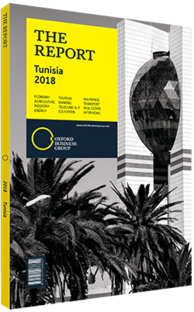Economic initiatives aim to support Tunisia's dinar and boost foreign reserves
The Tunisian dinar is pegged to a weighted basket of currencies, which includes the dollar and yen, but is dominated by the euro. In recent years, however, the government has introduced greater flexibility within the exchange-rate regime, in line with the IMF’s calls to do so. This has led to a significant devaluation of the country’s currency, from €1:TD1.91 at the end of 2010 to €1:TD2.94 in December 2017. Meanwhile, foreign-exchange reserves have fallen to the critical threshold of three months of imports-equivalent by the end of 2017, leaving little to no room for Tunisia to manoeuvre in the event of external shocks.
Under Pressure
With the Tunisian dinar increasingly reflecting underlying economic and financial conditions, the currency has been subject to the deterioration of a number of macroeconomic indicators, including the current account deficit and the public debt burden. While the current account deficit is suffering from the widening trade deficit – the former increased by 66.5% between 2011 and 2016, to TD7.9bn (€3bn) – the public debt burden rose in the years following the country’s 2011 revolution, from 39.2% of GDP in 2010 to 60% in 2016, and was projected to reach 69.5% by November 2017. Government attempts to tackle social tensions have brought the budget deficit to an estimated TD6bn (€2.3bn) in 2017, up from TD2.1bn (€806m) in 2011, accounting for 6.1% of GDP in both 2016 and 2017. In 2018 the government aims to reduce the budget deficit to TD5.2bn (€2bn) and to 4.9% of GDP, through the utilisation of tax hikes and a public sector hiring freeze.
Wider Impact
The devaluation of the dinar has had implications for the broader economy. A weaker national currency has contributed to rising inflation, affecting both consumers and imports-dependent companies. “The dinar lost around 30% of its value against the euro between 2015 and 2017, a trend that is likely to continue in the near future,” Wided Ben Naceur, private sector project manager at the French Development Agency, told OBG. “With Tunisia being a net importer, a weaker currency is increasing the difficulties faced by most sectors of the economy, as they depend on imported equipment for production.” In addition, the devaluation of the country’s currency has increased the weight of external debt, which represented 32.6% of total debt and 61.5% of the total public debt by 2016, making it relatively more costly. On the other hand, as a Europe-facing export centre, the fall in the value of the dinar relative to the euro has boosted the competitiveness of Tunisian exports. According to Fausi Najjar, regional director of Germany Trade and Invest, “Production costs in euros are weaker than the regional average, which makes Tunisia attractive as a production site.”
However, Ali Ayadi, country representative of the Centre for International Private Enterprise, told OBG, “The competitiveness of Tunisia’s exports is undermined by the significant importation of semi-finished goods, which implies that the government needs to encourage greater use of local materials.”
Intervention
Recent efforts to support the Tunisian dinar and foreign-currency reserves have been intensified, with both the government and the central bank, the Banque Centrale de Tunisie (BCT), intervening at critical moments throughout 2017.
While the BCT has led a tighter monetary policy, the government intends to grant amnesty to black-market operators and announced projects to allow Tunisians to open foreign-currency accounts. The 2018 Finance Law also includes a series of measures to reduce the growth of imports through new taxes targeted at consumer goods that are largely imported while supporting key sectors such as tourism.
Notwithstanding these continued, ongoing efforts to boost both the Tunisian dinar and foreign-currency reserves, those two indicators are intertwined with the performance of the Tunisian economy overall, which is set to experience only a slow recovery in 2018.
You have reached the limit of premium articles you can view for free.
Choose from the options below to purchase print or digital editions of our Reports. You can also purchase a website subscription giving you unlimited access to all of our Reports online for 12 months.
If you have already purchased this Report or have a website subscription, please login to continue.

